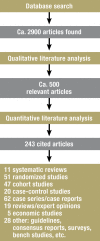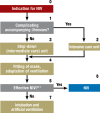Clinical practice guideline: non-invasive mechanical ventilation as treatment of acute respiratory failure
- PMID: 19626185
- PMCID: PMC2696903
- DOI: 10.3238/arztebl.2008.0424
Clinical practice guideline: non-invasive mechanical ventilation as treatment of acute respiratory failure
Abstract
Introduction: Non-invasive mechanical ventilation (NIV) has been used to treat acute respiratory failure (ARF) for approximately 20 years. This guideline addresses the indications for, and limitations of, NIV as treatment for ARF according to evidence-based criteria.
Methods: A panel of experts from 12 scientific medical societies reviewed circa 2900 publications. The panel judged the clinical relevance of these studies and assessed the evidence presented in each, then held two interdisciplinary consensus conferences to formulate guideline recommendations and algorithms.
Results: Whenever possible, NIV should be preferred to invasive mechanical ventilation, in order to avoid the risk of ventilator and tube-associated complications such as nosocomial pneumonia (grade of recommendation A). Particularly in patients with hypercapnic ARF, NIV reduces the rate of hospital-acquired pneumonia, the length of hospital stay and mortality in the intensive care unit and in the hospital (grade of recommendation A). NIV (or continuous positive airway pressure) is also recommended in cardiogenic pulmonary edema (grade of recommendation A), as treatment for ARF in immunocompromised patients (grade of recommendation A), to prevent postextubation failure, to facilitate weaning in patients with hypercapnic ARF (grade of recommendation A), and to improve dyspnea in palliative care (grade of recommendation C). NIV is not generally recommended in patients with hypoxic ARF because of its high failure rate of 30% to over 50% in such patients.
Discussion: Although evidence indicates that NIV can be used as the treatment of first choice for several indications, it is still underutilized in the acute setting. These guidelines provide evidence-based information about the indications for, and limitations of, NIV in the treatment of ARF.
Keywords: acute respiratory distress syndrome; evidence-based medicine; non-invasive positive pressure ventilation; respiratory insufficiency; therapy.
Figures





Comment in
-
Clinical practice guidelines in Deutsches Arzteblatt International.Dtsch Arztebl Int. 2008 Jun;105(24):423. doi: 10.3238/arztebl.2008.0423. Epub 2008 Jun 13. Dtsch Arztebl Int. 2008. PMID: 19626184 Free PMC article. No abstract available.
References
-
- Esteban A, Anzueto A, Frutos F, et al. Characteristics and outcomes in adult patients receiving mechanical ventilation: a 28-day international study. JAMA. 2002;287:345–355. - PubMed
-
- Brochard L, Mancebo J, Wysocki M, et al. Noninvasive ventilation for acute exacerbations of chronic obstructive pulmonary disease. N Engl J Med. 1995;333:817–822. - PubMed
-
- Esteban A, Frutos-Vivar F, Ferguson ND, et al. Noninvasive positive-pressure ventilation for respiratory failure after extubation. N Engl J Med. 2004;350:2452–2460. - PubMed
-
- Phillips B, Ball C, Sackett D, et al. Levels of Evidence. Oxford Centre for Evidence-Based Medicin. 2001
-
- Antonelli M, Conti G, Esquinas A, et al. A multiple-center survey on the use in clinical practice of noninvasive ventilation as a first-line intervention for acute respiratory distress syndrome. Crit Care Med. 2007;35:18–25. - PubMed
LinkOut - more resources
Full Text Sources

